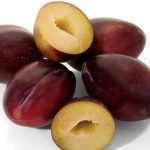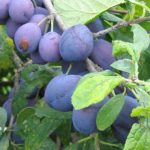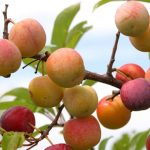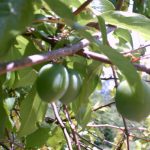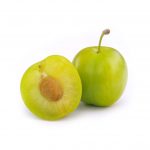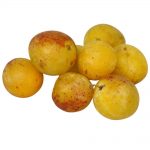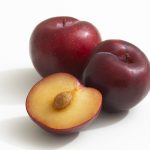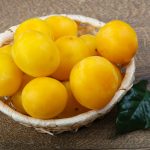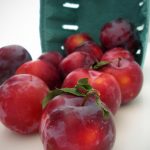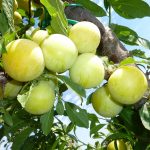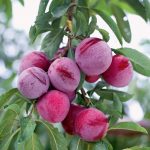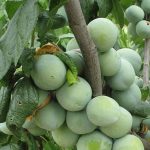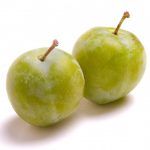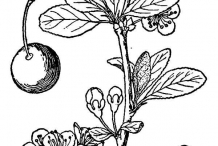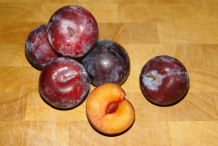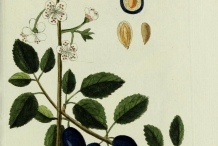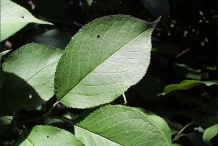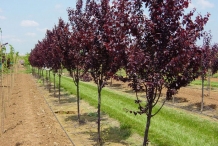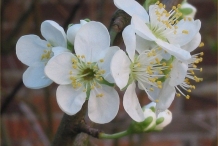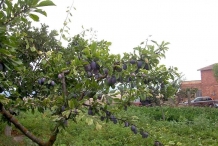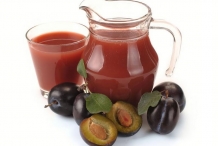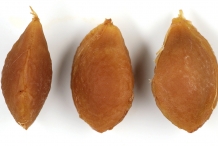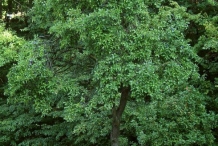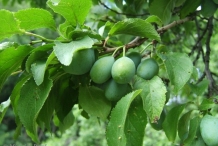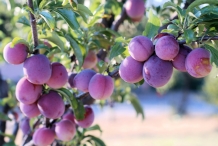Plant Description
Plum is a small, branched, deciduous tree that grows about 9 to 15 m (29 to 50 ft.) tall. It prefers a sunny well-drained, fertile soil. Clay loams are tolerated as long as drainage is good. Sandy soils are also suitable mainly if they are attached on nematode resistant rootstock. The plant has reddish-brown, glabrous branches, unarmed or armed with few spines. Branchlets are reddish-brown to greyish-green, and are pubescent. The plant has reddish to brown bark. Plums are grown commercially in orchards, but modern rootstocks, together with self-fertile strains, training and pruning methods, allow single plums to be grown in relatively small spaces like home gardens. Its early flowering and fruiting means that they require a sheltered spot away from frosts and cold winds for the better development of the plant. For the Essential Guide To Plum Tree Gardening
Leaves
Leaves are alternate, deep green, elliptic to obovate, 4–10 × 2.5–5 cm, pubescent below, glabrous above, margins serrulate, apex acute to obtuse, base cuneate with a pair of nectaries, and with 5–7 pairs of lateral veins.
Flower
Flower is solitary or in fascicles of 3 at the tip of branchlets, pedicellate (10–12 mm), 10–15 mm across. Hypanthium is pubescent; sepals 5, ovate with acute apex, imbricate; petals 5, white or greenish-white, obovate, apex rounded to obtuse, imbricate, on rim of hypanthium; stamens 20–30, in 2 whorls; filaments unequal; carpel 1; ovary superior, 1-loculed, glabrous or sometimes villous; style terminal, elongated. Flowering normally takes place from April.
Fruit
Globose to oblong, rarely sub globose fruit varies in size, but can be measuring about 5-6 cm in diameter with a hard, stony, flattened pit. The fruit is green when young turning to red, purple, purple black, yellow or golden yellow, often with a glaucous (white waxy) bloom on the surface. It is really an epicuticular wax covering and is also referred to as “wax bloom”. Skin is smooth yellow or dark red to purple or black. Inner flesh varies widely from creamy yellow, crimson, light-blue or light-green in color depending upon the cultivar type. The fruit has pleasant aroma and sweet and tart taste. Some varieties are usually sweet (dessert plum), though some varieties are sour and require cooking with sugar to make them palatable. Like all Prunus fruits, it contains a single large seed, usually called a stone, which is discarded when eating. An average weight of the fruit is about 50-70 g.
History
Prunus domestica is supposed to have originated in the area of the Caucusus and Asia Minor. First findings of primitive cultivars were reported to occur in Central Europe about 500 BC, probably known already by the Celtic and Teutonic tribes. Subsequently the fruit was dispersed to countries in central Europe by the Romans. It is probable that high quality cultivars originated from southeast Europe after the middle Ages, and distributed throughout Europe by the seventeenth century. Plum is now cultivated globally in temperate to warm-temperate regions, mostly in Central, S and SE Europe, further on in N Africa, W Asia, India and North America, Australia, New Zealand, South Africa and in South America.
Plum Varieties
There are many cultivars of plum. Plums come in a wide variety of colors and sizes. Some are much firmer-fleshed than others, and some have yellow, white, green or red flesh, with equally varying skin color. If you are thinking to grow Plum tree in your garden here are all the basics you need to know about Plum tree gardening.
These are some of the best-known:
1. European:
European plums are definitely the most generally grown plums since they do not usually need cross-pollination to bear fruit as well as develop in a number of the environmental circumstances through the U.S. European plums are perfect for consuming fresh or even canning because they’re more gratifying and much less succulent than other kinds of plums. Several types, just like tasty, oval-shaped Seneca plums, are usually sweet enough to consume fresh quickly the tree while some, like the even sweeter purple Italian plums, are perfect for drying out. Stanley plums would be the most adaptable as well as widely-adapted variety and therefore are ideal for consuming fresh, canning, baking and cooking . Some other types consist of French as well as German prune plums as well as Reine Claude plums.
2. Damson:
Even though a number of European plums, damson plums are believed a different kind of plum simply because they’re extremely sour, not really sweet just like various other European types. Due to their tartness, utilize damson plums to cook as well as protecting into jams as well as jellies. Types of damson plums consist of Shropshire and also French damson.
3. Japanese:
Sensitive Japanese plums, which usually originated from China, however arrived at the US through Japan, usually need cross-pollination along with other Japanese, American or even Japanese-American crossbreed types to bear fruit. Japanese plums additionally blossom at the beginning of spring but aren’t resistant of cold weather, which makes them more susceptible to frost harm. Starting from yellow to dark reddish purple colored, Japanese plums are usually bigger, juicier and fewer sweet as compared to European plums, causing them to be perfect for cooking as well as conserving. Even so, several types, such as dark red satsuma as well as the crimson-skinned, purple- and yellow-fleshed Santa Rosa, are perfect for consuming fresh or even canning. Some other types consist of Burbank, Ozark premier; Shiro, methley, as well as elephant heart plums.
4. American:
American plums, also known as bush or even wild plums, merge the hardiness of European plums together with the taste of Japanese plums but they are much easier to develop as compared to both. Even though indigenous to the eastern as well as central U.S., American plums can easily develop everywhere that European and Japanese plums cannot, which includes locations along with severe winter situations. In spite of their versatility to some variety of soils along with other environmental situations, American plums are susceptible to disease as well as unwanted pests. American plums are generally yellow or even red as well as, with their fairly sweet taste and higher pectin and also acid content, are ideal for protecting as well as producing jelly or perhaps jam but they are additionally great for fresh consuming.
5. Greengage Plums
Greengage plums are a green plum common in France. As you might guess, they fall into the European plum group. They have green skin and a greenish-yellow fruit that has a bit of a honey flavor to it.
6. Mirabelle Plums
These are the small, sweet plums with a slight reddish blush used for making eau-de-vie in France. They are the sweetest of all plums.
7. Red Plums
Red plums are so named because they have a bright red skin. Some, like the Santa Rosa, have amber fruit, but other red plums, like Simcas, have bright red flesh that matches their skins. The skin brings a tartness that balances out the sweet fruit. When ripe, these plums are pretty soft, so they don’t travel particularly well. Elephant Heart is another common red plum. Like all plums, they work well in jams or, Plum Chutney.
8. Yellow Plums
These plums are yellow inside and out. They are juicy with a nicely crisp fruit texture. Ripe ones will have just a slight give.
9. Sungold
It is a Japanese variety, whose fruit is big and aromatic and the skin is red when it matures. Yellow-orange and juicy flesh.
10. Red Beauty
It is a variety of the Japanese plum, with the rounded fruit, medium thick caliber, considering that it is a very early variety. It has red to dark red skin, depending on the maturity degree. This variety has yellow flesh, hard texture and good flavor.
11. Golden Japan
Thick, clear yellow fruit has thick and resistant bright skin, very juicy and pleasant pulp, belonging to the group of Japanese plum. It is cultivated in the U.S.A., France, Italy and South Africa, available from January to May and June to August. In Spain, the harvesting takes place in the middle of June.
12. Black Amber
This variety has black color, big size, round shape, a bit flattened. The pulp is amber; the firm flesh is not adhered to the bone and has wonderful taste. It comes from the U.S.A. and the maturation period in warm zones is during the last week of June.
13. Santa Rosa
It is a Japanese plum with a big, round and hearted fruit. This variety has deep red skin and Amber yellow or pale carmine flesh, very juicy, sweet and perfumed, with a flavor that reminds of the strawberry. It is from America, but mainly cultivated in France, Italy, Spain and South Africa. It is available from December to February (South Africa) and from June to November (in other producing countries). In Spain, harvesting takes place in the middle of July.
14. Reina Claudia Verde
It is a European plum of medium size, rounded, green, thin and juicy pulp and has characteristic scent and flavor. The stone comes off easily. It is excellent for table consumption, stewed or tinned fruit and jam. It is produced in Belgium, France, England and Spain. In Spanish warm areas the harvesting takes place in July-August.
15. Reina Claudia de Oullins
It is a European plum that has golden pale green fruit. It has very juicy and pale flesh, not very sweet flavor. The stone does not come off very easily. It is one of the most widespread varieties.
16. Angelino
It is a Japanese variety with great size fruits, dark red color and even darker when ripe. It has sweet flavor and yellow flesh. Not very productive but very good fruit conservation. Maturation take place from the middle to the end of September.
Health Benefits of Plums
Plum Fruits for human body is very amazing, mainly for preventing cancer. You call it plum when it is fresh, and you call it prune when it is dried, but both of them are full of nutrients. So no matter which type that you eat, you can still reap the benefits. They are packed with an immense range of phenols and flavonoids, which offer an impressive range of health benefits. Listed below are few of the health benefits of plum fruit
1. Cardiovascular Health
Regular consumption of plums is quite beneficial for maintaining cardiovascular health. Research has proven that the regular intake of dried plums helps in promoting fluidity of blood in the arteries. This protective effect aids in the prevention of various cardiac complaints, including the development of atherosclerosis and the reduction in chances for heart attacks and strokes.(1)
2. Prevent Cancer
Several researches have proven that the plum extracts have been proven beneficial in the treatment of cancer. Research has shown that the component epicatechin, present in plums, helps in preventing the growth and proliferation of malignant cancer cells and encourages apoptosis in human hepatocellular carcinoma or liver cancer. They are rich in antioxidants and phytonutrients, including chlorogenic acid and neo-chlorogenic acid which have a restorative effect on breast cancer cells, without harming the normal healthy cells of the body.(2)
3. Prevent Osteoporosis
Regular Consumption of dried plums exerts anabolic and anti-resorptive actions, which aid in maintaining healthy bones. Plums consist of Flavonoids such as caffeic acid and rutin which helps in preventing the deterioration of bone tissues and prevent diseases such as osteoporosis in postmenopausal women. Polyphenols, along with the potassium content present in dried plums, encourage the formation of bones, enhances bone density and prevents bone loss caused by ovarian hormone deficiency. Research has proven that regular consumption of dried plums helps in the restoration of bone density that has already been lost due to aging. (3), (4), (5)
4. Boost Immunity
Plums consist of Vitamin C which is proven beneficial in strengthening the immune defense of the body. It helps to promote the body’s resistance against various infections and inflammations. Research has shown that oriental plums have immune-stimulatory constituents that encourage the production of nitric oxide in the body, obstruct the metastasis of tumor cells, and are valuable in preventing various diseases.(6)
5. Skin Care
Plum consists of huge amount of vitamin C, along with other antioxidants, which help to maintain healthy, radiant and youthful skin. Regular consumption of plums helps in reducing dark spots and wrinkles due to the presence of anti-aging nutrients. Plum extracts are used in various skin care products such as face wash and packs. Additional Read: How Can Plum Fruit Helps You Fight Aging.
6. Macular Degeneration
Vitamin A and beta-carotene contained in plum are beneficial in maintaining healthy eyesight and preventing age-related macular degeneration. Carotenoids lutein and zeaxanthin present in them reside in the macular tissues of the retina and provide protection against the damage caused by UV radiation.(7), (8)
7. Fights Signs of Aging
Vitamin E and beta-carotene, an antioxidant in plums, protect the fatty acids and the cell membranes from the attack of the free radicals, which allows the body to fight the signs of aging skin such as loss of elasticity and wrinkles. Plum contains a high amount of antioxidants and high anti-inflammatory properties, which increase the circulation and cell metabolism, reducing inflammation. This, in turn, encourages the elasticity of the skin and keeps acne and wrinkles at bay.(9)
8. Control Diabetes
Plums use anti-hyperglycemic effects and help in combating diabetes. Research has shown that the consumption of plum extracts aids in the reduction of blood glucose and levels of triglyceride in the body. Flavonoids present in plums exert protective effects against insulin resistance and help to enhance insulin sensitivity in the body.(10)
9. Regulate Cholesterol Levels
Dried plums or prunes are quite helpful in preventing hypercholesterolemia and hyperlipidemia. Research has proven the effectiveness of prunes over grape-juice in maintaining healthy levels of plasma and liver cholesterol. Fiber content present in it also adds to the protective effect of the heart by reducing LDL cholesterol and helping to elevate the levels of HDL cholesterol (good cholesterol).(11), (12)
10. Blood Clotting
Plums and prunes consists of good amount of vitamin K, which helps in normal clotting of the blood and promotes bone health. Deficiency of vitamin K in the body can result in excessive blood loss and other health concerns such as weak bones.(13)
11. Aid in Digestion
Plums are a good source of dietary fiber, along with the components sorbitol and isatin, which help in regulating the digestive system. Research has proven that, dried plums or prunes are more effective in treating digestive disorders like constipation as compared to other remedies such as psyllium husk. Sorbitol and isatin have a laxative effect and encourage the secretion of fluids in the bowels and promote the efficient flushing of waste through the colon. (14)
12. Nervous System
Plums consist of vitamin B-6, which helps in the transmission of nerve signals and aids in the smooth functioning of the nervous system. They also help in the normal growth of the brain and assist in the formation of mood influencing hormones. Tryptophan, an amino acid present in them, helps in the production of the neurotransmitter serotonin, which plays an important role in sleep, appetite, and concentration.(15)
13. Aids in Weight Loss
Plums also remove toxins and prevent constipation, leading to weight loss naturally. Plum is rich in fiber and antioxidants, which aid proper digestion and good metabolism. It contains citric acid, which prevents tiredness and cramps. It also improves liver and gastrointestinal function. Thus, eating plums or drinking plum juice regularly will help you shed those extra pounds easily.(16), (17)
14. Useful in Pregnancy
Plum products are quite beneficial during pregnancy, due to the abundance of numerous vitamins and minerals. These beneficial components are vital for eye-sight, development of bones and tissues, and cellular health for the mother and the growing baby. Fiber content aids in preventing constipation and improves digestion. Inclusion of plums as a part of balanced diet helps in fighting various infections and maintains overall health. However, one should be careful regarding the choice of commercially available plum juices as they might contain high amounts of sugar.
15. May Relieve Constipation
Prunes and prune juice are well known for their ability to relieve constipation. This is partly due to the high amount of fiber in prunes. One prune provides 1 gram of fiber.
Fiber in prunes is mostly insoluble, which means it does not blend with water. It plays a role in preventing constipation by adding bulk to your stool and may speed up the rate that waste moves through your digestive tract. Additionally, prunes and prune juice contain sorbitol, which is a sugar alcohol with natural laxative effects.
In one study, people who consumed 2 ounces (50 grams) of prunes every day for three weeks reported better stool consistency and frequency compared to a group that consumed psyllium.(18), (19), (20), (21), (22), (23)
16. Treat Obesity
Plum extracts are valuable for treating obesity and other problems related with obesity. Researches have shown that consumption of stone fruits such as plums helps in fighting metabolic syndrome, due to the presence of bioactive compounds. Flavonoids and phenolic components such as anthocyanins, chlorogenic acids, quercetin, and catechins present in them exert anti-obesity and anti-inflammatory effects on the different bodily cells, including the fat cells, and they also help in preventing obesity-related problems such as cholesterol disorders, diabetes, and cardiovascular diseases.(24)
17. Cellular Health
Plums consist of iron and copper which assists in the formation of red blood cells and facilitates blood purification and healthy circulation. Copper in plums acts as an antioxidant and is essential for nerve health and aids in the formation of collagen. Consumption of copper-rich plums also helps in the absorption of iron and prevents various diseases such as anemia and osteoarthritis.(25)
18. Cure Influenza
Japanese plums are effective against the infection caused by influenza A virus. Research has shown that concentrated juice of Japanese plums contains lectin-like molecules which help in inhibiting and treating the infections caused by human influenza A virus.(26)
19. Improve Cognitive Health
Researches have shown that the flavonoids present in plum juice are effective in providing protection against age-related cognitive impairment. Beneficial phytonutrients present in plums help in reducing the inflammation in the neurological areas to improve learning and memory functions. Regular consumption of plums also helps in preventing age-related neurodegenerative disorders such as Alzheimer’s and Parkinson’s diseases.(27)
20. Eliminate Anxiety
Regular consumption of plums helps in reducing anxiety. Studies have provided supporting evidence regarding the anxiolytic effects and antioxidant properties of chlorogenic acids present in plums, which help in curing anxiety-related behaviors and damage caused by oxidative stress.(28)
21. Removes Dandruff
Vitamin C in the plum can help you get rid of dandruff. Hair follicles often get clogged due to dandruff and flaky skin. This damages the follicles and inhibits the hair growth, if not treated in time. Plums can help fight the bacteria on the scalp and soothe the skin to ward off dandruff. This will get rid of the follicles debris and encourage new hair growth.
Traditional uses and benefits of Plum
- Dried prunes are mildly laxative and are frequently employed in decoction.
- Dried fruit, known as prunes, is a safe and effective laxative and is also stomachic.
- Bark is sometimes used as a febrifuge.
- Plum blossoms have been historically used in the treatment of loose teeth, mouth ulcers, and sore gums.
- It is an effective ingredient in the manufacturing of mouthwashes and helps in curing bad breath and soothing sore throats.
Ayurvedic Health benefits of Plum
- Heat Exhaustion: Soak 3-4 plums in water for 6 hours. Mash the soaked plum with one glass of water and filter it. Drink it twice daily.
- Sweating: Take following Herbs 25 gm. Agar wood powdered, 25 gm. sandalwood powdered, 25 gm. Indian Rose Chestnut powdered and 300 ml plum juice. Boil the plum juice and add all powdered ingredients in boiling juice. Heat till the mixture becomes thick. Apply lukewarm mixture over the affected part once a day.
How to Choose and Buy Plums
- Plums can be found throughout the year but those with the best quality are usually seen between May and September.
- Pick plums with vibrant color while in the store and those still contain a bit of whitish bloom, suggesting that they haven’t yet been over handled. Steer clear of those that are soft, with cuts and bruises.
- Ripen plums give to slight pressure and have sweet fragrance.
How to store Plums
1. Store in room temperature till ripe, after that chill in plastic material bag.
2. To freeze plums:
- Wash and then leave entire or even slice in sections or even quarters and take away hole.
- In a soup pot, mix 2 3/4 cups sugar as well as 4 cups water, mix till the solution is apparent, and produce to the boil.
- Cool the syrup as well as put over plums.
- Put plums as well as syrup in protected air-tight pots or even heavy-duty freezer bags.
3. Freezer time revealed is perfect for highest quality only- food kept continuously frozen at 0° F will help keep secure forever.
Culinary Uses
- Ripe, plum fruit is sweet and juicy and it can be eaten fresh or made into jams, preserves, pastry, plum dumplings, and other foods.
- Plum juice can be fermented into plum wine; when distilled, this produces a brandy known in Serbia as Slivovitz , in Romania as Tzuica , in Hungary as Palink a and rakia or rakija in Albania, Bosnia, Croatia and Serbia.
- Acid plums are used for cooking.
- Prune juice is also a popular drink and is beneficial to health.
- Prune kernel oil is made from the fleshy seed kernel inside the pit.
- Plum flowers are used as garnish for salads and ice-cream or brewed into a tea plum-jam and dried prunes.
- They are used in baked goods and puddings, or as a condiment alongside meat dishes.
- Prune juice concentrate works deliciously well as a filling for candies and confectionery products, and as a binding agent for cereal bars.
- Plum chutney or dip is famous in Indian cuisine and is served along with stuffed Indian bread.
- It is also relished as a condiment along with the meat delicacies.
How to Use Plums in Recipes
If you are getting bored of just eating the fresh plumps again and again, here are some ideas of how to eat plums in a fun way.
1. Plum Tart
Make this healthy dessert for your family and your kids will surely love it. You don’t have to make it from the scratch, just buy the store-bought pastry and start baking. Add some other ingredients like almond if you like it to make it nutty. You can just use almost any ingredient that you love as long as it is healthy.
2. Plum Cake
Use any vanilla cake recipe that you like and add some cut plums on top of your cake batter as the topping. You will bake the plums and the cake together and finally you will find them very soft and tasty. It is better to use Italian plums for the best result.
3. Kale Salad
This recipe is very simple and easy. You only need to grill your kale quickly to make it crispy and then mix it with ricotta cheese and plums. The plums have to be seasoned first with olive oil, salt, honey, thyme, vinegar and pepper to make them taste delicious. It turns out great at the end and you don’t even need to spend hours in the kitchen.
4. Plum Pie
After the cake and the tart, now you get the pie and it is just as good as those. Buy a store-bought pie crust to make it easy and prepare the plums for the pie filling. You need to toast them first to make them soft and that is why finding the appropriate recipe is needed.
5. Taste of the Middle East
Kick chicken stew up a notch with the addition of prunes. Your close friends and family will probably be thankful for just how much structure as well as taste they add to delicious meals.
6. Dessert done healthy
Poach plums within red wine as well as spread along with grated lemon zest for a treat which will sit simple within your stomach. So innovative, but simple to make, you may simply select it over chocolate cake.
7. Chicken salad with a twist
Shred cooked chicken breast as well as stir in low-fat natural yoghurts. Include chopped plums as well as sliced up snow peas, and also fresh basil. It can make excellent sandwich filler for day meals.
8. Plum print cookies
If you’d usually make use of jarred strawberry jam to fill up thumbprint snacks, the next time you’re going shopping search for plum preserves to test rather.
9. Homemade plum sauce
To create your very own scrumptious topping for meats, or even to enhance a cheese tray, peel as well as mix juicy plums which has a little bit of cinnamon along with other spices or herbs (try out turmeric, nutmeg or even ginger).
10. Plum Bruschetta
You have this awesome plum bruschetta that will really make your day. You can firstly toss the plums and cherries together added with vanilla bean seeds, sugar, salt and oil until they release juices. Have your toast spread with ricotta cheese and then topped with your plums. They are just so delicious and healthy.
Plum Juice Beauty Recipes
Drinking the juice of fresh, succulent plums and using it for some of the easiest beauty recipes can be useful for you. While drinking plum juice can be refreshing, using the same for treating beauty problems can be absolutely hassle-free and rewarding. Get the best beauty benefits of plums with these recipes:
1. Plum Juice Hair Treatment
Mix freshly squeezed plum juice with whisked egg. Massage the hair roots with the concoction and leave it on the hair for about an hour. It works wonders for frizzy and dry hair.
2. Plum Juice-Honey Mask
Mix plum juice and honey in equal quantities, and use the mixture on your face to get glowing skin. Try including the juice of this wonder fruit in your daily life to gain its best benefits and remain healthy, naturally.
Other facts of Plums
- Green dye can be obtained from the leaves.
- Dark grey to green dye can be obtained from the fruit.
- Yellow dye is obtained from the bark.
- Gum obtained from points of damage along the stem can be used as an adhesive.
- Ground up seeds is used cosmetically in the production of face-masks for dry skin.
- Semi-drying oil is obtained from the seed.
- Wood is hard, compact and is used for musical instruments.
- China is the leading harvester of plums, followed by the United States, Serbia, and Romania.
- Production of fruit starts 3 to 5 years after planting. Productivity starts to decline after 10th year.
- Plum trees are grown on every continent except Antarctica.
- Serbian plum is the third most produced in the world.
- Plum blossom or meihua, along with the peony, are considered traditional floral emblems of China.
- In central England, a cider-like alcoholic beverage known as plum jerkum is made from plums.
- Plum remains have been found in Neolithic age archaeological sites along with olives, grapes and figs.
Plum Side Effects
Plums are sweet, but they still have some side affects you need to pay attention so that you won’t eat them too much.
1. Interfering Certain Medications
One of the plum benefits you can obtain is that they can lower your blood sugar. For people with high blood sugar this will be very great, but those who are going to have a surgery shouldn’t eat this. So if you are taking certain medications, confirm to your doctor first of whether or not eating plums is good for you.
2. Containing High Calories
If you eat fresh plums, you might not get as much as calories contained in prunes. However, since plums are not available all the year, then you might have to eat prunes instead. There are around 240 KCal of energy in just every 100 grams of prunes. This is a quite high calorie amount from a fruit because people usually don’t expect that much. You eat fruit because this is healthy and low calories, so when it has that high amount of calorie, would you still include it in your diet?
3. Increasing the Risk of Kidney Stones
How could that healthy food increase your risk of having a kidney stone? The answer is because its high amount of oxalate. This makes your body cant properly absorb calcium and leave it into deposits. These two things lead to kidney stone that you must be aware of. So if you are prone to this, ensure that you check with your doctor first.
References:
https://www.itis.gov/servlet/SingleRpt/SingleRpt?search_topic=TSN&search_value=24774#null
https://davesgarden.com/guides/pf/go/62430/
https://npgsweb.ars-grin.gov/gringlobal/taxonomydetail.aspx?id=29888
http://www.missouribotanicalgarden.org/PlantFinder/PlantFinderDetails.aspx?kempercode=n300
http://www.floracatalana.net/prunus-domestica-l
http://www.botanical.com/botanical/mgmh/p/prunes72.html
https://plants.usda.gov/core/profile?symbol=PRDO
http://www.theplantlist.org/tpl/record/tro-27800332
http://www.pfaf.org/user/Plant.aspx?LatinName=prunus+domestica
https://en.wikipedia.org/wiki/Plum
Comments
| Plums Quick Facts | |
|---|---|
| Name: | Plums |
| Scientific Name: | Prunus domestica |
| Origin | Southwest Asia |
| Colors | Green to red, purple, purple black, yellow or golden yellow, often with a glaucous (white waxy) bloom on the surface |
| Shapes | Globose to oblong, rarely sub globose, measuring about 5-6 cm in diameter |
| Flesh colors | Creamy yellow, crimson, light-blue or light-green |
| Taste | Sweet and tart taste |
| Calories | 76 Kcal./cup |
| Major nutrients | Vitamin C (17.44%) Carbohydrate (14.49%) Copper (10.44%) Vitamin K (8.83%) Total dietary Fiber (6.05%) |
| Health benefits | Cardiovascular Health and Prevent Cancer |
| Name | Plum |
|---|---|
| Scientific Name | Prunus domestica |
| Native | Southwest Asia |
| Common Names | Common Plum, European Plum, Gage, Garden Plum, Plum, Prune, Prune Plum |
| Name in Other Languages | Afrikaans: Pruim, Pruimedant Albanian: llokum Arabic: wazifat muhtarama (وظيفة محترمة), Barqûq, Iggâss Armenian: Salor (սալոր) Azerbaijani: Gavalı Basque: Inhar, Aran Bengali: Bara’i (বরই) Belarusian: зліву Bosnian: Sljiva Brazil : Ameixa-Comum, Ameixa-Européia, Ameixa-Preta, Ameixa-Roxa, Ameixa-Vermela Bulgarian: Sliva (слива) Catalan: Pruna Cebuano: Plum Chinese: Lizi (李子), Ou zhou li (欧洲李), Li zi, Mei zi, Yáng lǐ ( 洋李), Xīyáng lǐ (西洋李) Chichewa: Maula Croatian: Sljiva Czech: Svestka, Sliva Danish: Blomme Dutch: Pruim, Pruimenboom English: Common plum, European plum, Garden plum, bullace, bullace plum, common plum, Damson, damson plum, dawson, Prunes, wild plum Estonian: Ploom, Aedploomipuu, Harilik ploomipuu, Ploomipuu. Esperanto: Pruno Filipino: Sirwelas Finnish: Luumu, Luumupuu. French: Prune, Prune commune, Prunier domestique, Prunier cultivé, Prunier, Galician: Ameixa Georgian: K’liavi (ქლიავი) German: Pflaume, Bauernpflaume, Echte Pflaume, Hauspflaume, Kultur-Pflaume, Pflaume, Pflaumenbaum, Zwetschge, Zwispeln Greek: Damáskino (δαμάσκηνο) Gujarati: Plama (પ્લમ) Haitian Creole: Prin Hausa: Plum Hebrew: שזיף, Shazif Hindi: Ber (बेर), Alubukhara, Manukka Hmong: Txiv moj mab Hungarian: Szilva, Kerti szilva Icelandic: Plóma Igbo: Plọm Indonesian: Prem, plum Javanese: Plum Irish: Pluma Italian: Prugna, Susina, Susino, Prugno, pruno Japanese: Ume (梅), Seiyou sumomo, Seiyou sumomo, Puramu, Yooroppa sumomo Kannada: Plam (ಪ್ಲಮ್) Kazakh: Aлхоры Khmer: Proun (ព្រូន) Korean: Jadu (자두) Latvian: Plūme Lithuanian: Slyva Latin: Plum Lao: Plum Malagasy: Paisom-bazaha Malay: Plum Maori: Paramu Malayalam: plaṁ (പ്ലം), Arukam Manipuri: Heikha Marathi: Manukā (मनुका) Mongolian: Xar chavga (Xар чавга) Myanmar (Burmese): Jee see (ဇီးသီး) Macedonian: слива Maltese: Għanbaqar Nepali: Aalu bakharaa (आलुबखडा), Alu Bakhara Norwegian: Plomme Occitan: Prunièr Persian: آلو, Aalu Polish: Sliwka, Sliwa domowa (S of Sliwa has acute accent on top), Shliwa domowa. Portuguese: Ameixa, Abrunheiro, Abrunheiro-manso, Abrunho, Agruñeiro, Ameixeira, Ameixoeira, ameixa-comum, ameixa-européia, ameixa-preta, ameixa-roxa, ameixa-vermela Romanian: Prună, Šljiva Russian: слива(sliva), Sliva domashniaia, renklod, ренклод, слива домашная Scots : Ploum Serbian: Shljiva (шљива) Sesotho: Plum Somali: Khudaar bulug Swahili: Plum Slovak: Slivka, Bystrické slivky, Slivky, sliva Slovenian: Slive, Cheshplja, Sliva, češplja Spanish: Ciruela, Ciruelo, Pruna, Prunero, Pruno Swedish: Plommon Sinhala: Viyali midi (වියලි මිදි) Tajik: олу Tamil: Piḷam (பிளம்) Telugu: Plaṁ ( ప్లం), lpagodapandu Thai: Phlạm (พลัม) Turkish: Erik Ukrainian: слива(slyva) Urdu: بیر, Aalu bukhara Uzbek: Olxo’ri Vietnamese: (Quả) Mận, (Trái) Mận Welsh: Eirin West Frisian : Prom Yiddish: Floym (פלוים) Yoruba: Pupa buulu toṣokunkun Zulu: Ipulamu, Umplaamuzi |
| Plant Growth Habit | Small, branched, deciduous tree |
| Soil | Prefer a sunny well-drained, fertile soil. Clay loams are tolerated as long as drainage is good. Sandy soils are also suitable especially if they are grafted on nematode resistant rootstock. |
| Plant Size | 9 to 15 m (29 to 50 ft.) tall |
| Branches | Reddish-brown, glabrous branches, unarmed or armed with few spines |
| Branchlets | Reddish-brown to greyish-green, pubescent branchlets. |
| Bark | Reddish to brown bark |
| Leaf | Alternate, deep green, elliptic to obovate, 4–10 × 2.5–5 cm, pubescent below, glabrous above, margins serrulate, apex acute to obtuse, base cuneate with a pair of nectaries, and with 5–7 pairs of lateral veins |
| Flowering Periods | April |
| Flower | Solitary or in fascicles of 3 at the tip of branchlets, pedicellate (10–12 mm), 10–15 mm across. Hypanthium is pubescent; sepals 5, ovate with acute apex, imbricate; petals 5, white or greenish-white, obovate, apex rounded to obtuse, imbricate, on rim of hypanthium; stamens 20–30, in 2 whorls; filaments unequal; carpel 1; ovary superior, 1-loculed, glabrous or sometimes villous; style terminal, elongated. |
| Fruit Shape & Size | Globose to oblong, rarely sub globose, measuring about 5-6 cm in diameter with a hard, stony, flattened pit |
| Fruit Color | Green to red, purple, purple black, yellow or golden yellow, often with a glaucous (white waxy) bloom on the surface |
| Skin Color | Yellow or dark red to purple or black. |
| Flesh color | Varies widely from creamy yellow, crimson, light-blue or light-green in color depending upon the cultivar type. |
| Fruit Weight | 50-70 g |
| Seed | Single, smooth, flat, but hard pit. Seeds are inedible. |
| Flavor/Aroma | Pleasant aroma |
| Taste | Sweet and tart taste |
| Plant Parts Used | Plant Parts Used |
| Season | Jul to November |
| Major Nutritions | Vitamin C (Ascorbic acid) 15.7 mg (17.44%) Carbohydrate 18.84 g (14.49%) Copper, Cu 0.094 mg (10.44%) Vitamin K (phylloquinone) 10.6 µg (8.83%) Total dietary Fiber 2.3 g (6.05%) Potassium, K 259 mg (5.51%) Vitamin B5 (Pantothenic acid) 0.223 mg (4.46%) Vitamin B3 (Niacin) 0.688 mg (4.30%) Vitamin A, RAE 28 µg (4.00%) Vitamin B1 (Thiamin) 0.046 mg (3.83%) |
| Health Benefits |
|
| Calories in 1cup (165 gm) | 76 Kcal |
| Lifespan | Average lifespan is 10 to 15 years, but under optimal conditions it can grow up to 20 years. |



